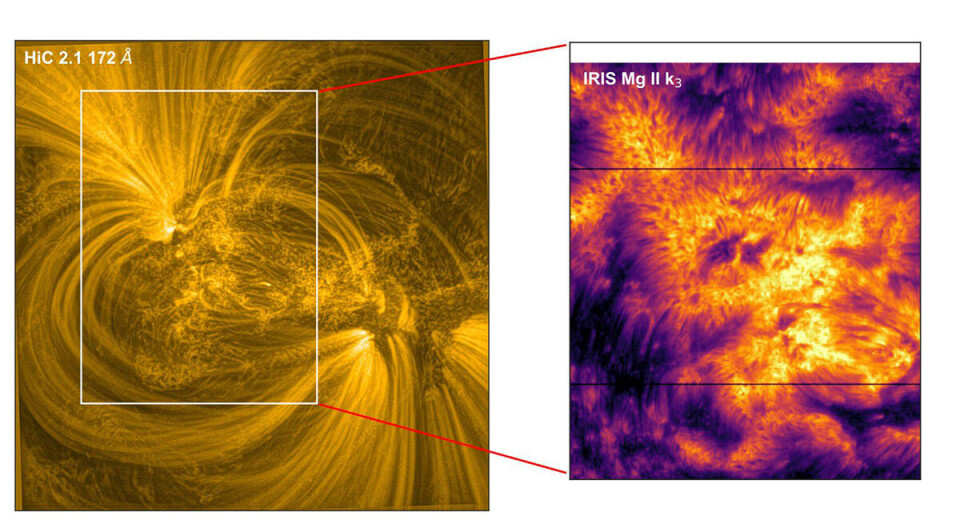THIS CONTENT IS BROUGHT TO YOU BY University of Oslo - read more

Why is the outer layer of the Sun's atmosphere the hottest?
The Sun's outermost layer is actually hotter than all the other layers combined. Solar researchers are now closer to an answer as to why that is.
There is a connection between the heating around sunspots in the chromosphere and corona, and the high temperatures in these layers.
Solar physicists Souvik Bose, Bart De Pontieu, and Viggo Hansteen have combined observations from the chromosphere and corona with machine learning.
This has brought them closer to solving the big question: Why is it hotter around the Sun than on its surface?
A new explanatory model
Earlier this year, researchers from the Rosseland Centre for Solar Physics (RoCS) published a scientific article on this in the journal Nature Astronomy.
Souvik Bose explains that they used high-resolution observations from two layers of the Sun's atmosphere, the chromosphere and the corona, combined with advanced numerical simulations.
The researchers utilised data from IRIS, a small space telescope that studies the chromosphere and the Sun's interface region, as well as from a sounding rocket. A sounding rocket can measure radiation, particle flows, and magnetic fields.
The solar researchers use the so-called Bifrost code, which allows them to model complex magnetic and hydrodynamic processes occurring in the Sun's atmosphere.
“The Bifrost code is designed to model the outer layers of the solar atmosphere and includes all the relevant physics needed to interpret the observations,” explains Viggo Hansteen.
With this, they may have solved part of the puzzle that has puzzled researchers for the past 25 years:
- The Sun's core reaches around 15 million degrees Celsius.
- The coldest layer, just above the photosphere, measures around 4,100 degrees.
- The temperature rises to 10,000 degrees in the chromosphere.
In the outermost layer, the corona, the temperature exceeds 1 million degrees. In some areas, it can rise to over 10 million degrees.
‘Moss’ on the Sun
Solar researchers use the term 'moss' to describe bright, patchy areas in the Sun's atmosphere, especially in the transition between the chromosphere and corona. These areas arise due to heating from magnetic processes. They also provide researchers with important information on how energy moves and is released in the Sun's atmosphere.
Souvik Bose explains that the physical mechanism heating the ‘moss-like’ areas around active, strong magnetic fields on the Sun to extremely high temperatures could be the key to understanding this heating.
He emphasises that it is still uncertain how widespread this mechanism is in other areas on the Sun. However, the researchers are pleased that their work contributes to solving the puzzle of the Sun's corona.
“Future high-resolution observations from the upcoming NASA Multi-Slit Solar Explorer, MUSE, will be necessary to fully understand how the corona and moss are heated,” says Bose.
RoCS researchers are contributing to this new spacecraft.
Discovered ‘invisible’ magnetic fields
The researchers discovered small, ‘moss-like’ patches around sunspots on the Sun. All these areas have extra strong, almost invisible magnetic fields.
These field lines generate electric currents that provide additional heating to the gas around them, on top of the heat already streaming from the overlying corona.
This could explain why the ‘moss’ around sunspots becomes much hotter than the Sun's surface, a phenomenon that has been challenging to understand due to the extreme heat.
According to Bose and Hansteen, the results align well with simulations and provide deep insights into the nature of the heating mechanism in active solar regions.
The researchers say that this discovery helps explain why the Sun's outer atmosphere, the corona, is so much hotter than the Sun's surface.
Reference:
Bose et al. Chromospheric and coronal heating in an active region plage by dissipation of currents from braiding, Nature Astronomy, vol. 8, 2024. DOI: 10.1038/s41550-024-02241-8

This content is paid for and presented by the University of Oslo
This content is created by the University of Oslo's communication staff, who use this platform to communicate science and share results from research with the public. The University of Oslo is one of more than 80 owners of ScienceNorway.no. Read more here.
More content from the University of Oslo:
-
Queer opera singers: “I was too feminine, too ‘gay.’ I heard that on opera stages in both Asia and Europe”
-
Putin’s dream of the perfect family
-
How international standards are transforming the world
-
A researcher has listened to 480 versions of Hitler's favourite music. This is what he found
-
Researcher: "AI weakens our judgement"
-
New, worrying trend among incels, according to researcher




































